Introduction
Week 1 - double fold hem (wovens)
Week 2 - single fold hem (wovens)
Week 3 - hemming stretch fabric
This week I tried out blind hemming. This lovely finish creates stitching which is virtually invisible on the right side of the fabric. It is used to hem garments, curtains and a wide range of other sewn projects. Read on to see how I used both hand and machine sewing to create blind hems.
Hand stitching
To begin I turned up the hem and pressed it and pinned it in place. I used a single fold, but you may choose a double fold. If you are using a single fold and the fabric is prone to ravelling it would be a good idea to overedge or overlock the hem edge first (in my example I use a selvedge edge).

Next I threaded a needle with a single thread and knotted it at the end. Using a single thread helps reduce the visibility of the stitching on the right side of the fabric.
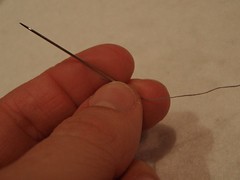
Next I gently rolled back the hem edge, anchored the the thread in the hem and then began stitching from right to left. Small stitches are taken in one layer of the fabric then the other.

First a small horizontal stitch ...
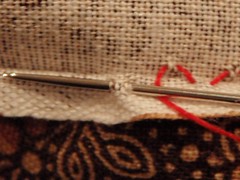
... then a tiny horizontal stitch, catching just a thread or two ... repeating this stitching pattern to the end of the hem. If this was a garment such as a skirt, I would overstitch every now and then to make sure that if a bit of the hem comes undone the whole thing doesn't come down!
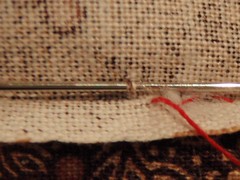
When I finished stitching I pressed the hem in place. Can you see the stitching?

Its hard to see on the right side too!
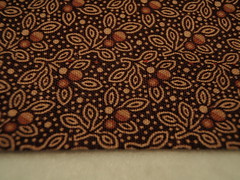
Machine stitching
I really should preface the next part of my experiment with the words: it didn't work like this the first time. Or the second or third!
I hadn't used my blind hem stitch foot before and really had to experiment to find the right settings. If you are new to blind hemming, I can highly recommend testing your blind hem foot on some scraps before tackling your project.
To begin, I turned up the hem and pressed it. I used a double fold, but you may choose just a single fold. If the fabric is prone to ravelling it would be a good idea to overedge or overlock the hem edge first.
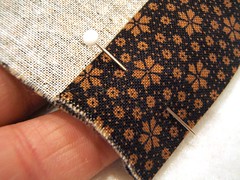
Now for a little trick: the edge of the hem needed to be rolled outward, exposing about a quarter of an inch. Like this ... (click on the pictures if you would like a close up)



To blind hem stitch I needed to fit a special presser foot on my sewing machine.
Each brand of sewing machine has its own special foot. In the demonstration here, I have a Janome foot. (It has a white plastic guide which can be adjusted - wound in and out - using the silver screw). If you have a blind hem foot and it looks quite different, don't panic. There is plenty of variation in the appearance between makes and models - consult your sewing manual for the finer detail of how your foot works.
If you have an adjustable guide on your presser foot, you may need to experiment with its position.
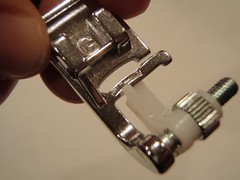
I also needed to select a special blind hem stitch. On my machine this is a repeating stitch pattern that has two short zigzags followed by one long zigzag. (In the picture below this is shown as stitch 11 on my sewing machine).
You might find that your sewing machines has a different style of repeating stitch - one that takes two straight stitches and then a zigzag.
Some sewing machines have both stitches. If you have this luxury, use the straight stitch for wovens and the zigzag for stretch fabric.
You may need to experiment with the stitch width to perfect your blind hem stitching.
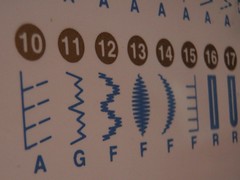
Then I positioned the exposed hem under the presser foot. On my foot the white plastic guide aligns with the fold. Check your sewing machine manual for instructions for your presser foot.
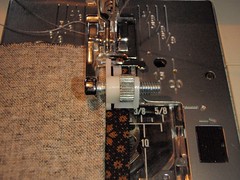
As I sewed I took care to just catch the left side of the hem with the long zigzag stitch. This part of the stitch shows on the outside of the hem, so it needs to be as small as possible.
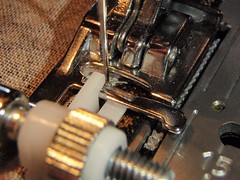
This is how the finished stitching looked. The long zigzag caught the left side by only a couple of millimetres.
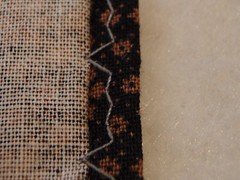
The next step was to roll the hem edge back inward. Like this ... (click on the pictures if you would like a close up)



After a quick press with the iron ....
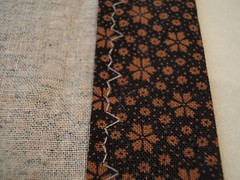
... the hem looked like this from the outside. You can see that if I used a matching thread, that it would be very difficult to see the stitching at all.
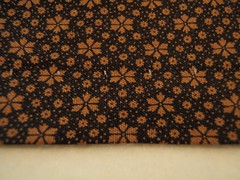
Conclusion
I really liked trying out both the hand and machine blind hemming and will use both again. In fact, I have already used the hand stitching technique again to finish a velvet skirt and a wool jacket. I'm looking forward to using the machine stitching on the next skirt I make.
Next time: A diversion to a garment-specific hem - the Euro or tricky hem for jeans. This magic technique shortens jeans, while preserving the original hem. After this I will be returning to general hemming techniques with rolled hems: by hand, machine sewing and overlocker.



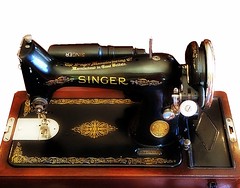


I've tried the machine blind hem stitch in the past, but it's been so long I have forgotten how to do it and not remembering how to fold the fabric made it all the more intimidating. So thanks for the very straight forward directions and photos!
ReplyDeleteI've done this by hand but I am going to have a try with my machine now,(hmm just need to remember where I put the manual....)
ReplyDeleteNow this is a post I am going to have to come back and read again! Thanks Liesl! :o)
ReplyDeleteSo helpful. Thanks!
ReplyDeleteOh my gawsh, I think I have that foot and wondered what in the world it was. Thanks for the instructions. Looks, relatively and deceptively simple.
ReplyDeleteI've never tried the machine stitch before...I should sometime, lol.
ReplyDeleteMy hand stitch looks a little different, too, though the result is the same. Interesting. :p
I find it fascinating how invisible this stitching can be.
ReplyDelete